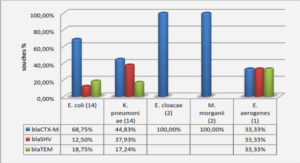Silicate assemblage
Stratigraphie profiles
Two stratigraphie profiles were reconstructed from hand specimen descriptions done by Hinterland Metals between 2006 and 2008 (Figure 2.5). The boreholes were distributed along two traverses aligned approximately E-W and N-S plunging 50-53 degrees north (except the drill hole EB07-14 plunging south, see Appendix 7 for descriptions). The area that has been drilled is 2.4km2 (1715 m x 1402 m) and is covered by 35 holes from 120 to 195 meters deep (Figure 2.5).
From these surveys, the stratigraphie columns were reconstructed and placed at their respective coordinates and elevations in order to reconstruct the layers at depth (Figures 2.6 and 2.7).
The correlation was made from Hinterland’s hand specimen descriptions, and we incorporated the samples we collected. The lithological layering occurs on a fine scale (<1m) thus the division of the units into melagabbronoritic and leucogabbronoritic is based on the dominant rock type in each layer.
North-South profile
On the N-S profile (Figures 2.5 and 2.6), the layers dip predominantly to the south with an open synform in the center of the section and some pinch and swell of the layers. Eight layers where defined from south to north and from the top to bottom. The sequence can be described as follows:
The top of the sequence, the southernmost layer (1) (Figure 2.6), corresponds to the map unit Acrb4 from Goutier (2005) and this layer is a leucogabbro. It is a grey-green gabbro, medium to coarse grained equigranular, and massive overall. It contains minor disseminated pyrite. The granitic dykes that intrude this leucogabbro are light grey/pink, coarse to very coarse grained with a pegmatitic texture; muscovite and minor disseminated sulphides are visible locally.
Layer (2) does not outcrop, but consists of a medium to dark-grey banded gabbro. It is very fine to medium grained, equigranular and massive. Minor disseminated pyrite is present. There is moderate pervasive alteration of amphibole to chlorite and minor potassic alteration of plagioclases towards the bottom of this interval.
Layer (3) corresponds to Acrbi unit of Goutier (2005) and outcrops over a large area even though it is one of the thinnest units. It consists of a dark speckled green melanogabbro that is medium-grained and weakly foliated (dipping 50°).
Minor disseminated sulphides are hosted in bands typically 5cm wide. There is weak pervasive alteration of amphiboles throughout. It is interbedded with bands of leucogabbro. This layer is characterized by the prescence of numerous dykes and veins of granite.
Layer (4) outcrops as Acrb4 of Goutier (2005); it is a pale-greenish white to dark green, medium-grained banded leucogabbro, and weakly foliated at 50° dip.
There are some narrow bands of anorthosite and melanogabbro present. Layer (5) does not appear on Goutier’s map (2005) probably because it is in the middle of the leucocratic Acrb4 bands and its width is too small to be mapped. This layer is a banded pale to dark green speckled melanogabbro, fine to mediumgrained. It has a strong foliation at 40°-50° (seen in the core samples). Some leuco gabbro is present. There is a gradational contact with the speckled gabbro.
Disseminated pyrrhotite, pyrite and chalcopyrite are present. There is weak pervasive alteration of amphibole in some cases.
leucogabbro. This layer is characterized by the prescence of numerous dykes and veins of granite.
Layer (4) outcrops as Acrb4 of Goutier (2005); it is a pale-greenish white to dark green, medium grained banded leucogabbro, and weakly foliated at 50° dip.
There are some narrow bands of anorthosite and melanogabbro present. Layer (5) does not appear on Goutier’s map (2005) probably because it is in the middle of the leucocratic Acrb4 bands and its width is too small to be mapped. This layer is a banded pale to dark green speckled melanogabbro, fine to mediumgrained. It has a strong foliation at 40°-50° (seen in the core samples). Some leuco gabbro is present. There is a gradational contact with the speckled gabbro. Disseminated pyrrhotite, pyrite and chalcopyrite are present. There is weak pervasive alteration of amphibole in some cases.
East-West profile
The E-W profile was drawn considering the dip of the holes, thus, our profile was drawn E-W, but is inclined 50 degrees towards the north as many of the holes are off course with respective corrections for holes with a different plunge. Thus the width is relative and corresponds to an inclined view (Figure 2.7).
|
Table des matières
ABSTRACT
RÉSUMÉ
AKNOWLEDGEMENTS
LIST OF FIGURES
LIST OF TABLES
LIST OF APPENDICES
CHAPTER 1 INTRODUCTION
1.1. Objectives of the Study
1.2. Classification of Platinum-Group Element Resources
1.3 Layered Intrusion Hosted Platinum-Group Deposits
CHAPTER 2 GEOLOGY
2.1 Previous Work
2.2 Stratigraphie profiles
2.1.1. North-South profile
2.1.2. East-West profile
2.1.3. Generalized stratigraphie column
CHAPTER 3 PETROLOGY
3.1. Silicate assemblage
3.1.1. Metagabbros
3.1.2. Felsicrock
3.2. Sulphide assemblage
3.3. Platinum Group Minerals (PGM)
CHAPTER 4 GEOCHEMISTRY
4.1. Analytical Methods
4.1.1 Whole Rock Major and Trace Element Methods
4.1.2 Whole Rock Nickel, Copper, Sulphur and PGE-Au Analyses
4.2 Major elements
4.2.1. CIPW Norm and Rock Classification
4.3. Trace elements
4.4. Sulphur, Ni-Cu & PGE-Au geochemistry
4.4.1. Relationships among the PGE
CHAPTER 5 DISCUSSION
5.1. Magmatic events in the Bell River Complex
5.1.1 The sulphides
5.2. PGE behaviour and implications for exploration
5.3. PGE layer location
5.4. Formation processes of the Ebay’s PGE reef 1
5.5. Comparison to other PGE deposits
CHAPTER 6 CONCLUSIONS
BIBLIOGRAPHY
![]() Télécharger le rapport complet
Télécharger le rapport complet





